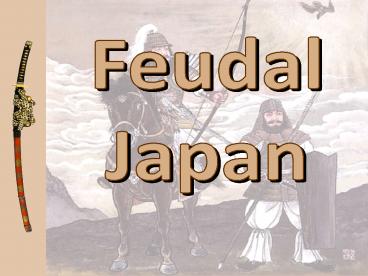Feudal Japan PowerPoint PPT Presentation
Title: Feudal Japan
1
Feudal Japan
2
Heian Period 794-1156
- Characteristics
- Growth of large land estates.
- Arts literature of China flourished.
- Elaborate court life highly refined
- Personal diaries
- The Pillow Book by Sei Shonagon 10c
- Great novel
- The Tale of Genji by Lady Murasaki Shikibu
1000 pgs. ?
3
Heian PeriodCultural Borrowing
- Chinese writing.
- Chinese artistic styles.
- Buddhism in the form of ZEN.
- BUT, not the Chinese civil service system! ?
4
Heian Court Dress
5
The Pillow Bookby Sei Shonagon (diary)
6
The Pillow Bookby Sei Shonagon (diary)
7
Tale of Genji (first novel)
8
Tale of Genji Scroll(first novel)
9
Lady Murasaki Shikibu
She contributed much to the Japanese script known
as kana, while men wrote with Chinese characters,
kanji.
10
Minamoto Yoritomo
Founded the Kamakura Shogunate 1185-1333
11
Medieval Japan
- ___________ supreme military
leader - _________ powerful, land-owning
- landlord
- ____________ professional warriors
- ____________low, non-ruling class
Top
Shogun
Daimyo
Samurai
Peasants
Bottom
12
The emperor reigned, but did not always rule!
Feudal Society
13
Samurai
- ? Knights of Japan
- ? Highly respected and feared
- ? Followed _____________
- - Code of ethics
Bushido
14
Code of Bushido
- Courage
- Honor
- Obedience
- Loyalty
15
Seppuku Ritual Suicide by Sword
It is honorable to die in this way.
Kaishaku his seconds
16
Full Samurai Attire
17
Samurai Sword
18
Early Mounted Samurai Warriors
19
Underpinnings Basic Steps in Self Defense
A COTTON BREECH CLOUT that extended up over the
chest was the basic undergarment of a samurais
costume
A SHORT SLEEVED KIMONO, or armor robe, was
tied snugly at the waist with a special knot
(lower right)
20
BILLOWING PANTALOONS,worn over the armor robe,
fitted loosely in the legs to allow freedom of
movement
AN EXQUISITE BROCADE, richly worked with a design
of peonies, was one of the extravagant materials
used in an armor robe that may have been made for
a 14th Century imperial prince
STURDY SHINGUARDS of cloth or leather were
reinforced with strips of iron to give protection
from the front
21
Samurai Charging
22
Modern-Day Samurai Warriors
23
Feudalism
A political, economic, and social system based on
loyalty, the holding of land, and military
service. Europe
King
Land - Fief
Loyalty
Lord
Lord
Land - Fief
Loyalty
Knight
Knight
Knight
Food
Protection
Peasant
Peasant
Peasant
Peasant
24
Code of Chivalry
- Justice
- Loyalty
- Defense
- Courage
- Faith
- Humility
- Nobility
25
Medieval Warriors
vs.
European knight
Samurai Warrior
26
Medieval Warriors
vs.
Knights Armor
Samurai Armor
27
Zen Buddhism
- A Japanese variation of the Mahayana
form of Buddhism, which came from India
through China. - It reinforced the Bushido values of mental
and self-discipline.
28
MongolInvasionsof Japan
4,400 ships and 140,000 men, but kamikaze winds
stopped them.
29
Ashikaga Age 1338-1573
- Shoguns fought for power.
- Laws are unclear.
- Less efficient than the Kamakura.
- Armies of samurai protected the country. ?
30
CASTLES
31
Osaka Castle
32
Main Gate of Hiroshima Castle
33
Caernorfon Castle, Wales
34
Warwick Castle, England
35
R O E N S
36
The Age of the Warring States(1467 - 1568)
- Castles built on hills in different
provinces. - Power shifts from above to below.
- Europeans arrive in Japan ? bringing
firearms Christianity. - Christianity foreign trade flourish.
37
Oda Nobunaga (1534-1582)
- Banishes the last Ashikaga shogun.
- Unifies a large part of Japan.
38
Catholic Jesuits in Japan
St. Francis XavierFirst Catholic Missionaries
in Asia
39
Toyotomi Hideyoshi(1536-1598)
- Becomes suspicious of European
territorial ambitions. - Orders all European missionaries expelled
from Japan. ? - Tries to invade Korea, but fails.
40
First Christian Martyrs (1597) Shrine in
NagasakiToday
41
Tokugawa Ieyasu (1543-1616)
- Appointed shogun by the Emperor.
- Four-class system laid down with marriage
restricted to members of the same class! ? - Warriors.
- Farmers.
- Artisans.
- Merchants.
42
Tokugawa Shogunate Period
- Japan closed off to all trade except to the
Dutch and Chinese. ? - The Dutch were restricted to a small island
in Nagasaki harbor. - Japanese Christians persecuted and
Christianity is forbidden. - The government is centralized with all power
in the hands of the shogun. - Domestic trade flourishes.
- Towns, esp. castle towns, increase.
- Merchant class becomes rich! ?
- New art forms ? haiku poetry, kabuki theater.

